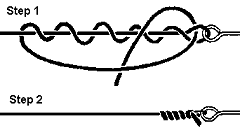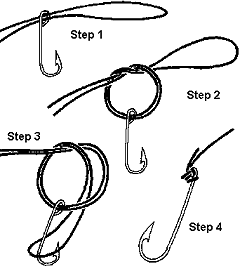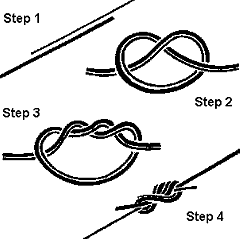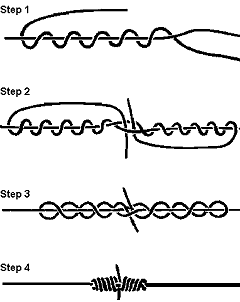

Useful Knots:
 Clinch
Knot
Clinch
Knot
- Pass the line through the eye of the hook, or swivel.
- Double back. make five turns around the line.
- Pass the end of the line through the first loop, above
the eye, and then through the large loop. Draw the knot into shape.
- Slide the coils down tight against the eye.
 Palomar
Knot
Palomar
Knot
The Palomar Knot is another very simple knot for terminal
tackle. It is regarded by the International Game Fish Association consistently
as the strongest knot known. It's great virtue is that it can safely be tied at
night with a minimum of practice.
- Double about 12.5cm of line, and pass through the eye.
- Tie a simple Overhand Knot in the doubled line, letting
the hook hang loose. Avoid twisting the lines.
- Pull the end of loop down, passing it completely over
the hook.
- Pull both ends of the line to draw up the knot.
Snelling A Hook
One small problem is the variety of names that may be
applied to the one knot, for example, a Granny is a False Knot, a Clove Hitch is
a Waterman's Knot, an Overhand Knot is a Thumb Knot. But when we come to
snelling a hook, the length of nylon attached to the hook may be a snell or a
snood.
I now find that the actual job of tying the snood may be
called snoozing, while snelling is often jealously thought of as an art
restricted to the fly fisherman. I have fished with bottom-fisherman on the
Great Barrier Reef who routinely snell their hooks.
Restricted to lines of breaking strength less than about
20kg, the process is a simple one.
- Pass the end of the line, trace or tippet through the
eye twice, leaving a loop hanging below the hook.
- Hold both lines along the shank of the hook.
- Use the loop to wind tight coils around the shank and
both lines, from the eye upwards. Use from 5 to 10 turns.
- Use the fingers to hold these tight coils in place. Pull
the line (extending from the eye) until the whole loop has passed under
these tight coils.
- With coils drawn up, use pliers to pull up the end of
the line.
Tying 2 lines together
 Surgeon's
Knot
Surgeon's
Knot
Earlier mention was made that if the two lines to be joined
vary greatly in their diameters, the lesser line may be doubled at the knot, or
the Surgeon's Knot may be used. In the latter case, it will probably be
necessary to have one of the lines rolled on a spool, or perhaps wrapped on a
temporary card, so that it may be passed through the loop.
- Lay the two lines against each other, overlapping about
22.5 cm.
- Working the two lines as one, tie an Overhand Knot. It
will be necessary to pull one line (say the leader) completely through this
loop.
- Pull the leader through this loop again.
- Pass the other end through the loop.
- The formed knot can now be worked into shape.


 Blood
Knot
Blood
Knot
- Lie the ends of the two lines against each other,
overlapping about 15cm.
- Take 5 turns around one line with the end of the other,
and bring the end back where it's held between the two lines.
- Repeat by taking 5 turns around the other line, bringing
the end back between the two lines. These two ends should then project in
opposite directions.
- Work the knot up into loops, taking care that the two
ends do not slip out of position.
- Draw the knot up tightly.













![]() Clinch
Knot
Clinch
Knot

![]() Palomar
Knot
Palomar
Knot

![]() Surgeon's
Knot
Surgeon's
Knot

![]() Blood
Knot
Blood
Knot
